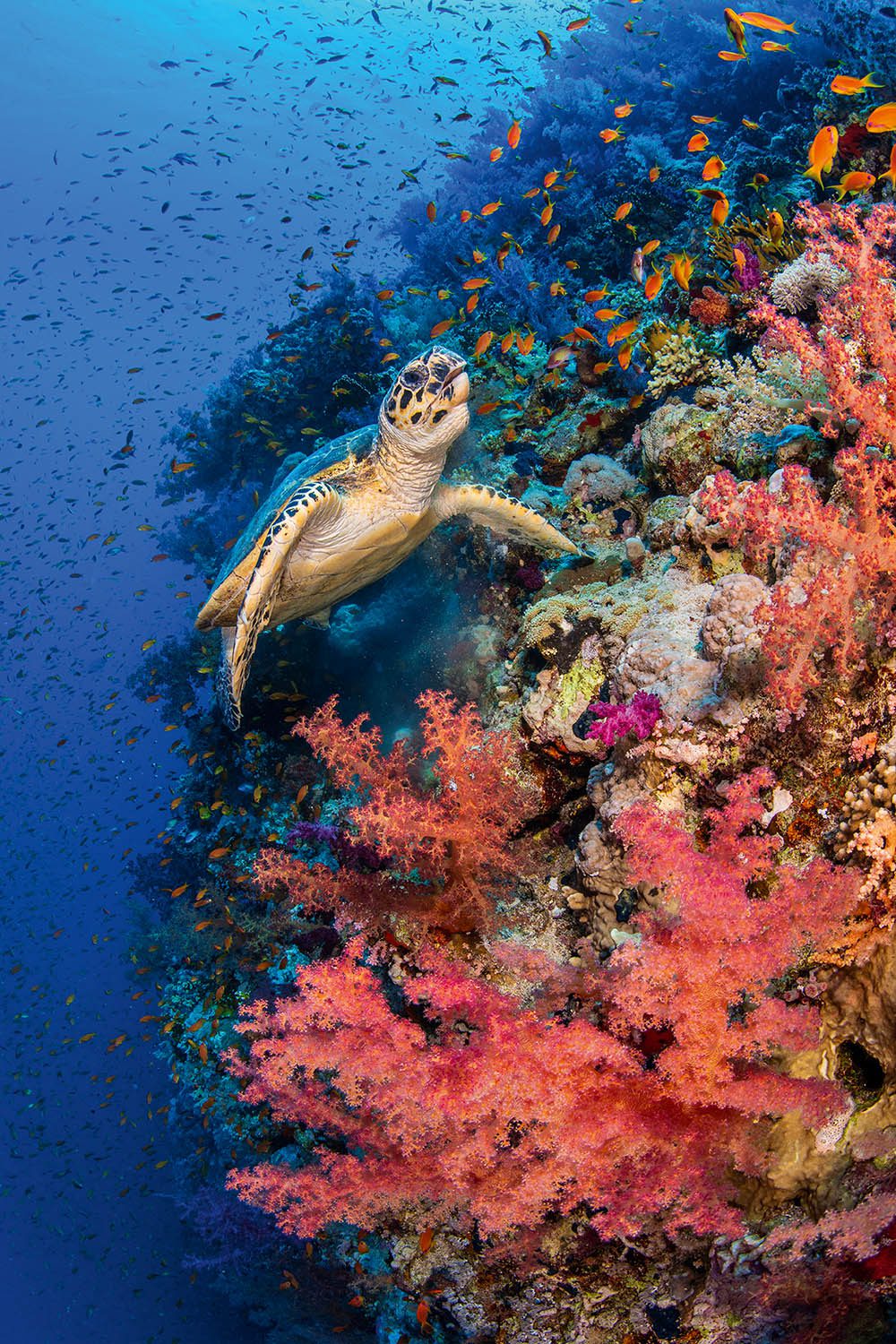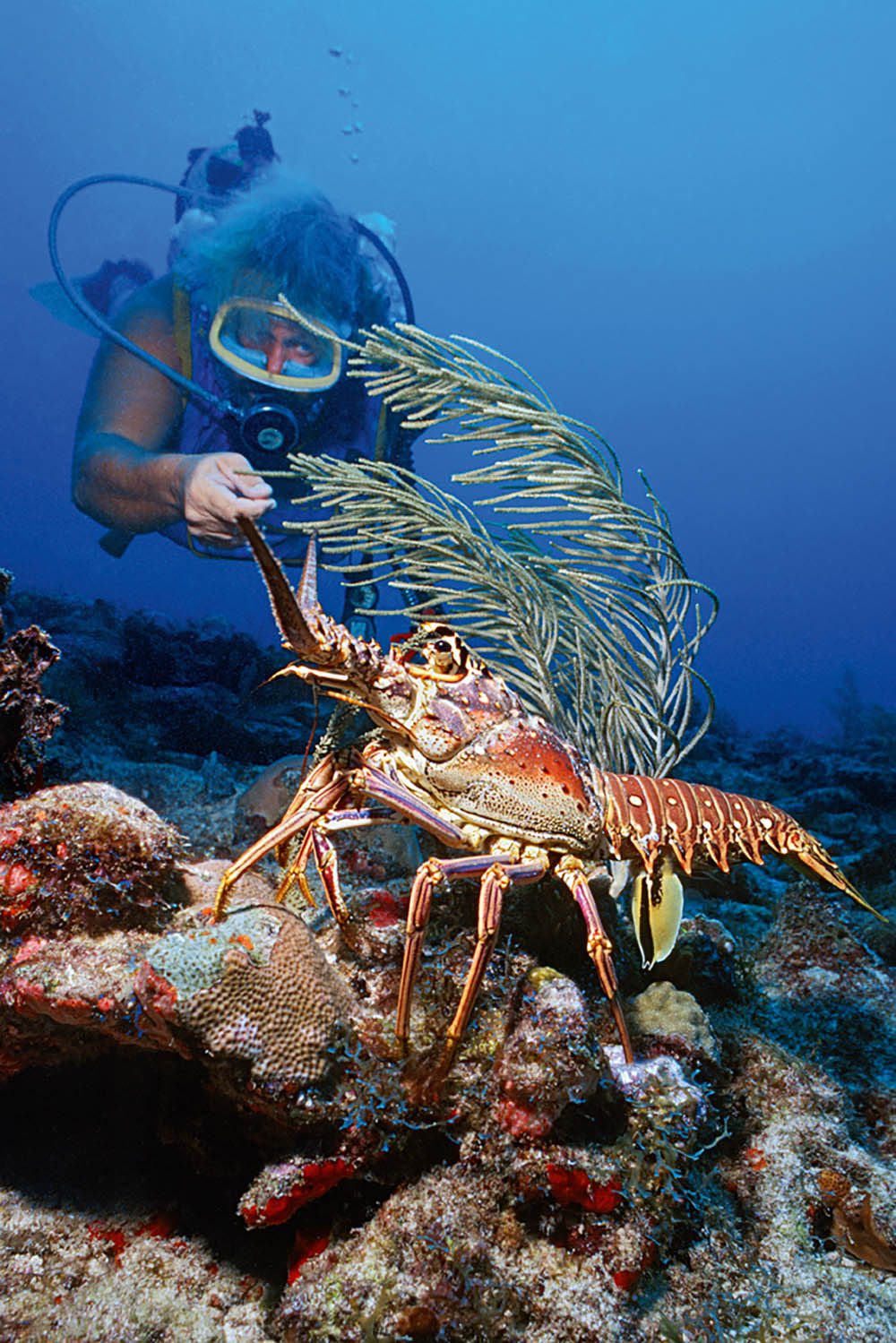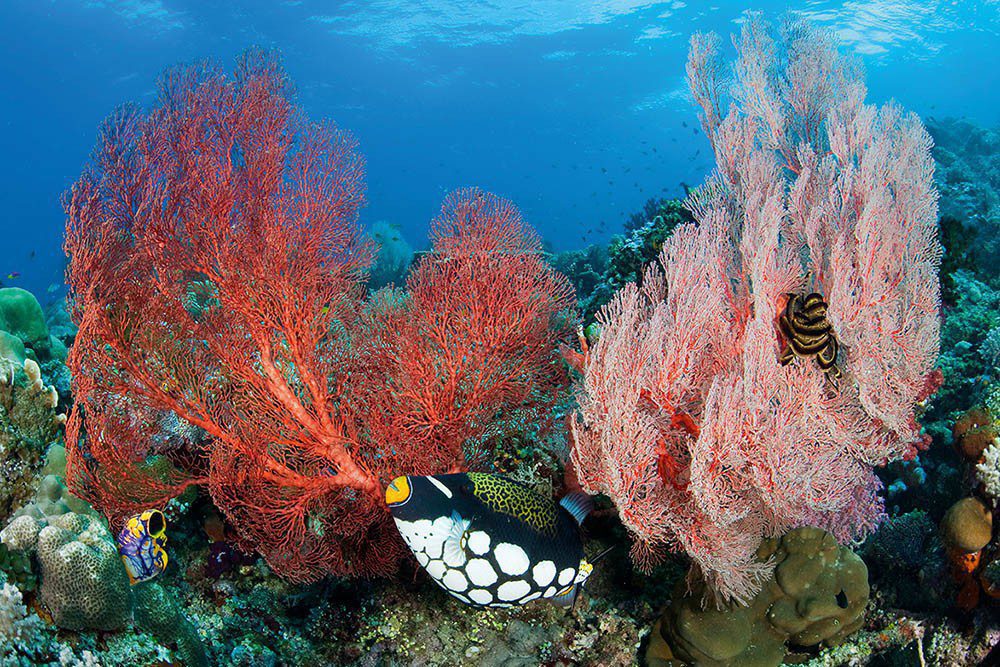PHOTO TECHNIQUE
Not so much a camera, more a way of life – that was the Nikonos. ALEX MUSTARD draws on the lessons learnt of necessity with pre-digital underwater cameras to help widen the choice of shot available to us today
‘When there is nothing available, carry on and fill the frame.
When there is, try the Nikonos-style shot’

I could easily have filled the frame with this friendly turtle, but I feel the image tells a more interesting story with the subject smaller in the frame.
Taken with a Nikon D850 and Nikon 8-15mm. Subal housing. 2 x Seacam strobes. 1/100th @ f/13, ISO 320.
EARLIER THIS MONTH
EARLIER THIS MONTH there was a tantalising morsel of underwater photography news when Nikon re-registered the Nikonos name as a trademark. Perhaps the move was linked to Nikon’s new Z-mount Mirrorless cameras? We shall see.
Nikonos was the name Nikon used from the 1960s to 1990s for its amphibious cameras, designed for underwater use without the need for a housing. For most of that history these were robust viewfinder cameras (the fully manual Nikonos III from 1975 and automatic Nikonos V from 1984 were the standout designs) and were the pre-eminent weapon of choice for the majority of serious underwater shooters at the time.
So dominant was this camera that books weren’t written about underwater photography, but instead about using your Nikonos.
Not requiring a housing, or the plethora of buttons of a modern digital camera, meant that they were simple and hold-in-your-hand small, more compact than most “compact” camera housings today.
Their superpower was that Nikon produced (expensive) wide-angle lenses that were specifically designed to work under water and still outperform even the best modern lenses, which must be used behind a domeport under water.
Nikonos kryptonite was that the cameras were leaky. A popular dive T-shirt at the time read: “There are two types of Nikonos photographers – those that have flooded their camera, and those that will”. I still remember feeling dizzy and sick as I poured the Indian Ocean out of one of mine.
These classic Nikonos models were viewfinder cameras, which meant that you couldn’t look through the lens or see what it was seeing on a screen – instead, you had a separate viewfinder with which to guestimate your photo.
This didn’t really hinder us from shooting, but it did steer us towards certain compositions.
When shooting with a viewfinder, we could never be sure exactly where the edges of the frame would fall.
The solution was to avoid totally filling the frame with the subject, and instead compose the subject within the picture, balanced with another element, or elements.
These days, when shooting larger marine life, photographers tend to focus mainly on the main subject, which can be very dramatic. In the Nikonos era, photographers thought more about the balance of the whole frame, shooting a subject as part of a scene.
It is a subtle but important difference. For me there is no right or wrong approach. My view is that we shouldn’t just settle for one, but should be trying to work both types of image into our portfolio.
This makes now the perfect time to resurrect that trademark Nikonos “fish in a scene” picture.
WHEN I COVER this approach to shooting on my workshops, the most common question is: “What sort of other elements should I be looking for to complement the subject?” There is no secret formula. The key is to be mindful of what is available.
When shooting scenic wide-angle, experienced photographers are used to searching for background elements first, and then finding a good foreground in the same area to set against it.
A slightly different approach is needed for the Nikonos-style shot, because the main subject and supporting elements are not foreground and background, but both in the foreground and illuminated by our strobes.
The trick is to find your subject and, before rushing in to fill the frame and shoot, to look around it for the other elements to incorporate.
When there is nothing available, carry on and fill the frame. When there is, try the Nikonos-style shot.
STARTER TIP
One of the first laws you learn about underwater photography is that the closer you get, the better your pictures. These animals-in-their-environment-type shots are not taken from distance, but you should shoot from slightly further away than normal.
Typically just 20cm further away is enough with a wide-angle lens to transform the composition.

Taken more than 25 years ago, when viewfinder cameras forced us to avoid filling the frame with the subject, but bring in other elements.
Nikonos V and Nikonos 15mm lens. 1 x Nikon SB102 strobe. 1/60th @ f/8, ISO 100.
The challenge is to be mindful of this option before charging in. And this takes one of the hardest skills to master, the ability to think clearly at that crucial moment and avoid what rugby folks call “white-line fever”. The term’s rugby roots refer to someone driving for the try-line and ending up tackled by a defender, rather than passing to someone in space with a simple run in.
The cure for white-line fever under water is to remember to look for the Nikonos option when we see a great subject. Sometimes not racing in to completely fill the frame will result in a more memorable image.
We should look around the subject for attractive elements of the environment that could be incorporated into the picture. Obvious examples are pretty soft corals or seafans, smaller reef life or even a diver.
Start by composing the subject off-centre, looking into the frame. Then consider the surroundings: if there is one obvious feature, position it on the opposite side to the subject. If there are two elements, position them either side of the subject. The goal is simply to produce an attractive, balanced picture.
MID-WATER TIP
The viewfinders of Nikonos cameras showed you a wider scene than the camera would record, with a frame estimating the bounds of the final photo. This provided a kind of periphery vision for the photographer, making it easier to appreciate surrounded elements that could be brought into the composition.
When using a modern camera, pan up and down and side to side to check for subject matter you could exploit.
One of the best options for creating a pleasing picture around the subject is to look for a natural frame within the frame. Large fish often lurk beneath overhangs, and these can be used to set off the subject.
Wrecks are particularly productive, with marine life sheltering in arches and caverns created by the twisted metal.

Compose the frame considering the elements of the environment and not only the main subject.
Taken with a Nikon D700 and Sigma 15mm. Subal housing. 2 x Inon strobes. 1/80th @ f/8, ISO 200.
THE NIKONOS-STYLE image works because it produces a “life in the landscape” type of image – a picture that shows the animal clearly, but also attractively illustrates its habitat.
Because such images are about nature we need to illuminate the entire scene in a naturalistic way to communicate this feeling. We need to shoot a balanced-light picture, where the light from our strobes, which is essential for bringing out the colours in the scene, is perfectly balanced with the ambient light.
This balance must go beyond a simple balance of the quantity of light (the exposure of the strobes and the ambient light) and must also balance in terms of the quality of light to feel natural.
ADVANCED TIP
Even, soft illumination does not sound as exciting as more advanced lighting techniques, such as inward lighting or off-camera strobes. Don’t be deceived that this means it is easy.
This style of lighting takes the utmost skill and finesse to perfect. Being a master of soft, even lighting usually marks out the most accomplished underwater photographers.
Ambient light under water is diffuse, so we must strive to match it with soft, even lighting from our strobes. This means we need to add diffusers, pull them back to avoid any hotspots or shadows in our lighting, and take great care with their positions and powers.
Ironically, the other flaw in the Nikonos design was that it had only one socket for attaching a strobe. And two strobes are far better than one for the type of picture it specialised in producing.
Strobes on either side of the camera produce much more even and soft lighting, reducing the shadows in our images because each helps to fill the shadows produced by the other.
Fortunately, these days it’s straightforward to use two strobes, allowing us to be inspired by the past, but to greatly exceed what was possible in the Nikonos days.

